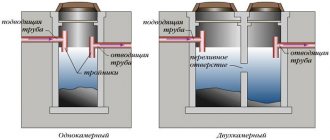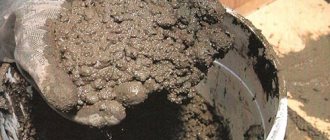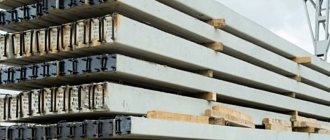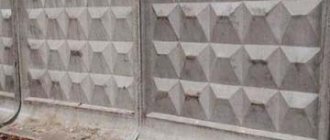Making holes in building structures (floors, columns, walls) made of concrete is a complex procedure from a technical point of view. Especially if we are dealing with high-strength reinforced concrete, starting from M300. The best technological solution to such problems is diamond drilling. To be more precise, the technology is called: diamond core drilling.
Core drilling is a method of making holes; drilling is done only along the perimeter of the hole, and the concrete core itself (what is enclosed in a circle) is removed from the cavity of the crown after drilling is completed. Diamond core drilling of reinforced concrete is a modern technique, it is used in work of various sizes.
A diamond crown looks like an ordinary metal pipe of arbitrary diameter, with particles of technical stone (diamond) soldered to its surface. With the help of these diamond particles, they interact with concrete and immerse themselves in its body.
Important! Drilling concrete differs from drilling only in that impact force is used in its production.
Application of diamond drilling rigs
During construction and repair work, we often encounter the need to make cylindrical holes of medium and large diameter in building floors, walls, columns and other structures made of monolithic concrete, reinforced concrete, stone, brick. From a technical point of view, this procedure is complex; it cannot be performed using a conventional drill or hammer drill. Cope with the task within the capabilities of a diamond drilling installation.
Drilling rigs with diamond drill bits are used in the construction and reconstruction of buildings, roads, bridges and other structures.
This method of making holes is most in demand when performing the following types of work:
- when making holes in walls, door and window openings;
- when laying heating, sewerage, gas and water supply systems;
- when installing ventilation and air conditioning systems;
- when dismantling building foundations;
- when installing equipment;
- when installing fences and other decorative structures.
The use of diamond drilling rigs makes it possible to make holes even in such high-strength material as reinforced concrete.
Advantages
Diamond cutting and drilling have a number of positive features. Therefore, the presented methodology is widely used in private and industrial construction. The positive qualities of diamond drilling are as follows:
- The work is completed quickly. If the room has been prepared for drilling, the procedure takes no more than a few hours. The speed depends on the characteristics of the material and the complexity of the task.
- The resulting hole has smooth edges that just need to be lightly sanded.
- Clear geometry of the resulting opening.
- Drilling is carried out in walls, ceilings, foundations of any hardness, including surfaces made of granite, porcelain stoneware, basalt.
- Even in small, narrow spaces, drilling rigs are used.
- Dust and dirt are practically not formed.
- Relatively low noise level.
- Possibility of creating holes in almost any position. You can make channels at an angle.
- The absence of vibrations has a positive effect on the integrity of the structure. The appearance of cracks and faults is excluded.
Due to these advantages, the presented equipment is often used during installation and dismantling.
Pros and cons of diamond drilling
The main advantages of diamond drilling include speed and safety of work, production of perfectly smooth holes of various depths and diameters, low labor and energy costs.
Let's list the main advantages of using installations:
- creation of smooth, neat holes with a diameter of up to 1 m and a depth of up to 5 m in high-strength structures;
- drilling speed (about 5 cm/min) - achieved due to the high rotation speed of the diamond bit;
- no need for additional surface treatment;
- Carrying out work in hard-to-reach places at an angle is possible due to vacuum (anchor) fastening of the frame;
- absence of vibrations and high noise during operation;
- comparative purity.
The disadvantages of the technology include the following points:
- high cost of equipment and components;
- high probability of engine failure and damage to diamond bits in case of non-compliance with technological requirements;
- bulkiness - sometimes causes spatial restrictions when performing work;
- availability of professionalism and experience of the installation operator.
What else can affect the cost of work?
Of course, the cost of the service primarily depends on the material that is supposed to be drilled and the size (depth) of the hole. But there are other circumstances that affect the price.
Factors that increase the cost of work lead to increased consumption of material (diamond crowns) and create additional difficulties for work. For example, the cost of making a hole will increase if:
- The hole must be made in a concrete slab with a high degree of reinforcement.
- Drilling must be done from bottom to top.
- Drilling is carried out in rooms with finishes that need to be preserved. In this case, the drilling areas are covered with film, and a bucket is placed on the floor to collect the dirty water that flows down.
Advice! If you do the wall covering yourself, you can save on the cost of the service.
In addition, the need to work in cramped conditions, work in an unheated room in winter, work at night, etc. can lead to an increase in price. So, we can clearly conclude that diamond drilling is the most progressive and convenient way to make a hole in concrete or other hard material
Principle of operation
The operating principle of the installation is to drill holes by immersing a diamond bit into concrete. In this case, drilling is carried out not in the center, but along the perimeter of the hole. At the end of the work, the resulting concrete core is removed from the crown cavity.
Drilling is carried out in two ways: dry and wet. The dry method is used if it is necessary to maintain the cleanliness of the structure. Its disadvantage is the possibility of overheating and breakdown of equipment segments, as well as the formation of dust during work. The drilling method using liquid is used much more often than the dry method. Particularly effective for making holes in high-strength materials. During work, the liquid washes away dust from the surface being treated and has a cooling effect. Water collection is carried out using an additional device - a sludge collector (catchment ring).
Drilling concrete using diamond drilling rigs, unlike drilling, is carried out using the impact force of the tool.
Organization of the concrete drilling process
A characteristic distinctive feature of the procedure is the ability to drill on concave and convex surfaces, such as tunnels or arches. An important criterion for choosing the type of drilling between dry and wet is the type of surface, type of material structure, as well as working conditions:
Drilling without the use of liquid is used infrequently, only in cases where there is no water collection, danger of electric shock, and so on.
Diamond drilling of reinforced concrete using moisture to cool the bit is used more often.
Well, now about how the preparation process is built at a construction site.
Preparation for work:
first, the required diameter of the diamond bit and a specific drilling rig are selected, according to the required diameter and surface material, markings of the future diameter of the hole are applied to the concrete surface, the supply of water, electricity, as well as the removal of sludge (drilling waste) is organized
Manufacturing jobs:
The first stage is the installation and fastening of the drilling rig frame; for this, holes for anchors are drilled on the surface. The frame is installed on this fastener. At this stage, you need to make sure there are no gaps in the joints or fastening points of the frame.
The second stage is turning on the installation, selecting the speed, supplying water and suctioning dust and liquid. During drilling, it is important to prevent the bit from skewing to avoid the bit getting stuck and damaging the cutting elements. Under no circumstances should the motor be turned on when the crown is lowered; this will also lead to damage to the cutting element. When drilling concrete, it is necessary to slightly increase the pressure of the bit on the surface, not forgetting about the timely supply of water. The main task at this stage of drilling is that the motor must not be overloaded; this often happens due to the friction of the bit against the walls of the hole. Friction most often occurs due to the displacement of the bed during drilling, and the reason for the displacement of the bed is its weak fixation to the surface.
Design
Main elements of diamond drilling rigs:
- beds;
- engine;
- diamond crown.
The bed is the basis of the drilling rig. It consists of a guide post and a mounting plate. The frame allows you to clearly fix the engine in the desired position on a vertical or horizontal surface with or without an inclination, to avoid distortion.
A motor with a diamond bit, which is used to insert the tool deep into the surface, moves along a guide post. On the rack there is a carriage with a motor mounting device and a screw, rack or chain feed mechanism, which is responsible for the movement of the carriage along the rack.
Diamond drilling rigs can be purchased as a complete set, consisting of a frame and engine, or individually. When choosing a rack and motor, it is necessary to take into account the compatibility of the type of carriage and mounting device and the possibility of using diamond bits with the same diameter.
In manual models, the engine can be operated without a stand. For ease of use, the designs are equipped with additional handles.
Types of diamond drill bits for hammer drills
The cheaper the drill, the less durability and performance you can expect from it
All drills are divided into the following types:
- screw - self-sharpening. These drills have a design that allows you to very quickly remove sludge from the cutting area. They are mainly produced with an SDS Plus shank and are used for installation and repair of not very heavy building structures;
- spiral. They usually have a large diameter. A spiral drill for a concrete hammer drill, the dimensions of which allow deep holes to be made, is used when installing air conditioners or dismantling not very thick walls;
- flat. With the help of such drills, holes of small depth are made. Their advantage is that they have a longer service life than spiral ones.
Drills are used for different purposes, differing in design, quality and price. Based on cost, all drills can be divided into three categories.
Drill price categories:
- the most inexpensive drills. These drills are only suitable for one-time use. Sometimes they are not even marked;
- drills for home use, produced by reputable companies. Such a tool is more expensive compared to consumer goods, but it will last longer, for example, concrete drills for a rotary hammer, Hilti sizes;
- drills for professional equipment. Such drills are considered the most expensive, but they are of the highest quality. Therefore, if finances allow, then it is better to buy just such a diamond drill for concrete.
For home use, you can buy a concrete drill for a hammer drill, which belongs to the middle price category (Stayer, Matrix, Bergen, Zubr). When choosing a drill, remember that it is a consumable item and cannot be repaired . Therefore, you should not buy a concrete drill made by someone unknown, the price of which is very low. Such a drill can break the hammer drill chuck so much that even a very good tool in it will break.
Diamond crowns
An equally important component of the equipment is the equipment in the form of diamond bits: the specifics of the types of work performed depend on their quality no less than on the characteristics of the installation itself.
A diamond drill bit is a kind of metal pipe made of medium-hard steel. On the end side of the pipe there is a thread or a device for attaching to the drilling machine engine, and on the other side diamond segments are soldered in the form of protrusions, the diameter of which is larger than the diameter of the body itself.
Segments with diamond crystals can be present only on the end part of the case, or can additionally be located on the outside. The presence of additional segments allows drilling to the full depth of the tool.
The body of core drills can be either solid or have holes of various sizes and shapes.
Crowns vary in diameter and depth. The length of the crowns is standard, it is 450 mm. Usually it is enough to drill walls or floors of standard thickness.
Problems of dry drilling
As was said earlier, the absence of dust during the work process is one of the main advantages of diamond technologies. However, the inability to supply water to the cut immediately creates a number of problems:
- Formation of pervasive dust
- Overheating of the annular drill leads to a decrease in work efficiency up to a complete stop (“clouding” of the segment), and failure of expensive equipment is also possible.
- Drilling products clog the crown, causing it to jam in the hole.
Thus, a vicious circle has turned out: all the advantages of the technology become its disadvantages, and key aspects of operation are impossible to implement.
We’ll tell you separately about the so-called. “blurring” or “licking” a segment. During operation, the diamond removes the material being processed with its sharp edges and corners, equally effectively dealing with concrete and iron reinforcement. Over time, the cutting surface becomes rounded (“licked”) and ceases to perform its function. In conditions of water shortage, this process accelerates significantly: old “worn” diamonds are washed away faster than new, sharp ones have time to open. It turns out that the crown rotates, the engine and operator roar from the effort, and the hole does not deepen - there are no working surfaces on the crown.
How to choose the right one
The choice of equipment presented on the modern market is difficult. The range of diamond drilling rigs is wide - the designs differ in power, spindle speed, drilling diameter and other characteristics.
When choosing equipment, first of all, you need to start from the desired diameter of the holes and the texture of the surfaces being processed. It is important to take into account indicators such as engine power, rotation speed, and the range of diamond bits.
Let us dwell in more detail on the performance characteristics of installations for diamond drilling of surfaces made of durable materials.
Drilling reinforced concrete with micro-impact
However, the need to drill a monolith dry pushed equipment and tooling manufacturers to search, research and invention. In 2022, a domestic manufacturer of diamond tools developed the “Diamond Hit” series bits, which allow drilling reinforced concrete without water. The segment bond is designed in such a way that it is constantly destroyed by micro-impacts produced at a frequency of 22,000 Hz - which the installation tells it - revealing new, sharp diamonds. The impact energy is so low that, despite the name, the nature of the work remains shockless. Thus, using special crowns and installations with a pulse operating mode (“Pulse Tech”), it became possible to carry out full diamond drilling of reinforced concrete without water.
Description of the tool
The main components that make up the unit used for diamond drilling are a rigid frame, a motor or electric motor (drive), as well as special diamond bits or spiral drills, which act as a direct working tool. During work, the bed is rigidly fixed using a special plate directly to the surface in which drilling will be carried out. If necessary, this unit can be mounted near the surface that will be processed with its help.
Depending on the model of the machine, its working mechanism may also consist of a gearbox, a manual or electric pump that supplies water, an oil tank, and a dust removal system (dust collector).
There are several different types of these machines that are used for drilling. When drilling small holes, with a diameter of no more than 120 mm, on surfaces such as a brick wall or concrete floor, small manual drilling machines are usually used.
To make holes with a larger diameter, units of a more complex design, frame type, are used. In such machines, a motor with diamond bits is mounted directly on the frame itself and is able to move smoothly during drilling directly along the axis of rotation.
On a note! Bed-mounted drilling units, compared to similar manual tools, are more versatile. Thanks to their use, you can perform a wide range of tasks. In addition, when using them, the accuracy of the hole being made, relative to its diameter and angle, increases significantly.
Small, bed-type machines are stationary equipment that allows diamond drilling. However, it is worth noting that to perform tasks of increased complexity, there are also special units that, by their design, are mounted implements. As a rule, they are installed on excavators - loaders, special road construction machines, and so on. As a rule, units equipped with wheeled chassis do not appear on the domestic construction market. However, in world practice, during construction work, such self-propelled machines are quite often used when working with materials of increased strength, for example, such as reinforced concrete.
Electric motors and internal combustion engines can be used as a drive in machines for performing diamond drilling. In addition, in some models, a hydraulic or pneumatic motor can be used as a drive.
Advice! The selection of the unit by type (electric, gasoline, and so on), as well as the power of the power drilling drive, primarily depends on factors such as the diameter of the holes that need to be made and the strength of the materials with which it is intended to work.
The most powerful devices are hydraulic type. They are used when performing a variety of tasks with monolithic, highly reinforced concrete, or strong rocks.
Features of the units
Thanks to the development of modern technologies, universal tools and specialized equipment appear that make it possible to make holes of different diameters in materials with high strength indicators, to cut durable concrete pavements accurately, in a short time and safely. The use of special drilling equipment with diamond coating significantly speeds up the process of surface treatment during both repair and construction activities. Also, quite often such devices are used when dismantling structures or during redevelopment.
The principle of work, in which diamond-type drilling is actively used, comes down to the use of a special unit consisting of a motor, a sprayed bit, and a device called a stand. Thanks to the use of this equipment, you can quickly drill holes of almost any diameter, cut special niches in the walls, or, if necessary, create special openings.
Important! The use of such machines when processing hard surfaces (for example, when creating special niches or openings inside walls) is absolutely safe for adjacent structures standing nearby. When using such installations, there are no strong vibration loads that can destroy structures.
When using machines for diamond drilling, destruction of the surface being processed occurs pointwise, directly in the place where the drill of the unit operates. Absolutely no cracks appear on the surrounding structures located near the surface that is being processed during construction activities. The holes made with the help of such units are absolutely flat, with a smooth surface and do not require additional processing.
The advantages of diamond drilling include:
- Accurate adherence to all parameters when performing various tasks;
- Rate of drilling process (1-5 cm per minute);
- No strong noise;
- Absence of huge amounts of dust during surface treatment and drilling;
- The ability to drill in both horizontal and vertical planes at the angle required by the installation operator.
To use such a machine, you will need to be connected to an electrical outlet, as well as a water supply (to eliminate dust generated). Such devices can be used to make holes for water pipes or other utility communications.
Review of the best popular manufacturers and models of diamond drilling rigs
What is the best diamond drilling machine to buy, how much does it cost? The modern construction equipment market is represented by a variety of such units from a large number of manufacturers in different price categories. The most popular, best manufacturers of such units, which occupy a high rating among other companies, are:
- BOSCH. A worldwide popular company that produces convenient, reliable and high-quality tools. The installations presented by this company are perfect for both dry drilling and for performing a variety of construction tasks using water. Additionally equipped with a soft start and dust removal system.
- Hilti. The equipment presented under this brand is considered one of the highest quality and most productive. This company mainly produces compact and lightweight models that are suitable for hand drilling.
- WEKA. A popular German manufacturer that produces equipment with an increased level of wear resistance and reliability. Units produced under this brand have a long service life and high-power engines.
- Elmos. The devices manufactured by this company are used for drilling large diameter holes in materials of increased strength (for example, granite, stone, asphalt surfaces, concrete). The devices are equipped with speed control and can be used to perform various tasks in inclined planes.
- CARDI. This brand mainly produces industrial-type machines that are designed for operation in highly complex conditions. They are equipped with several speeds and are capable of creating holes with a diameter of up to 600 mm.
- DIAM. The installations of this manufacturer are distinguished by their quality and reliability. As a rule, most models produced under this brand are equipped with a special inclined stand, which allows you to perform surface drilling within the range of 30-150 degrees.











